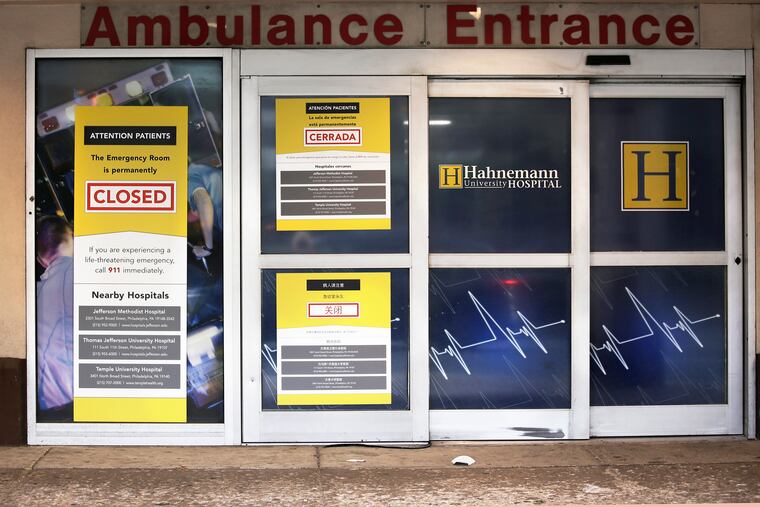With Hahnemann closed, expect more shootings to turn into homicides | Brain Trust
The only difference between a nonfatal and fatal shooting could be access to health care.

The issue: The number of homicides in Philadelphia has increased in four of the last five years. But even though fatal shootings make up the vast majority of homicides, shooting and homicide trends don’t necessarily go hand in hand. For example, in 2017 the city experienced 54 fewer shootings total, but 25 more fatal shootings than it did in 2016.
Giovanni Circo, a professor of criminal justice at the University of New Haven, and his coauthor, Andrew Wheeler, a professor of criminology and criminal justice at the University of Texas at Dallas, wanted to unpack the relationship between fatal and nonfatal shootings. Looking at data from Philadelphia, they wanted to know if the location in the city in which the shooting occurred affected survival for those shot.
The bottom line: “The farther away you are [from a level 1 trauma center]," Circo says, "the more likely it is you’re going to die from your injuries.” That means immediate health-care access is a crucial element in reducing deaths from gun violence.
Taking a step back. For every homicide in Philadelphia, there are about four nonfatal shootings. “The issues that drive nonfatal shootings are the same things that drive homicides,” Circo says. However, “historically, we focused only on homicides.” That is changing. “Now we are starting to realize that nonfatal shootings have just as much of an impact on the victims and communities — if not more, because there [are] really so many.”
The preferred way to prevent homicides is to make sure that the trigger is not pulled in the first place. But if it is pulled, knowing what increases the probability the victim will survive is an important step.
» READ MORE: America’s hidden toll of gun violence: shooting victims face lifelong disabilities and financial burdens
The research question: “Does being shot in a certain neighborhood increase or decrease your likelihood of dying based on how close you are to a hospital?"
To answer this question, the researchers used data on shootings in Philadelphia between January 2015 and June 2019, which is available through Open Data Philly (the availability of this information is one of the reasons they chose Philadelphia as the subject of their study). They were able to map the 5,580 shootings in relation to the five level 1 trauma centers that the city had during the study period -- Albert Einstein Medical Center, Hahnemann University Hospital, Penn Presbyterian Medical Center, Temple University Hospital, and Thomas Jefferson Hospital. The researchers calculated the distance between each shooting and the nearest trauma center. But, Circo notes, even relative proximity to a trauma center doesn’t guarantee someone will arrive in good time: “You might be stuck in traffic or something.” Using historic driving time data from Google, the researchers were able to calculate how long it would have taken to drive from the location of the shooting and the nearest level 1 trauma center.
The researchers found that being shot close to a trauma center dramatically increased the probability of survival. “If you are shot in the torso, and you are within a quarter mile of a trauma center, your predicted probability of death is something between 18% or 20% versus being a mile or half a mile away where it starts going up to like 24% or 26%.” These increases might seem small, but in a city with more than 1,300 shootings a year, that could be a reduction in dozens of homicides.
Why does this matter to Philly? These findings are bad news for anyone hoping to see the city’s homicide rate going down. Over the summer, Philadelphia lost one of its level 1 trauma centers when Hahnemann shut down because it didn’t make enough profit for its owners. For shooting victims coming from north or northeast of Center City, but still closer to Center City than Temple, Hahnemann’s closure could add a mile of travel -- and very slow travel in Center City congestion, depending on the time of day. That additional distance could contribute to a dramatic increase in the number of homicides Philadelphia will experience next year. Then there’s the impact on the four remaining trauma centers that have to absorb the cases that would have gone to Hahnemann.
» READ MORE: Hahnemann’s closure will hurt patient care | Opinion
And while health officials so far say that Hahnemann’s closure did not lead to the crisis that was expected, there is still reason for concern. Most shootings occur in the summer, and next summer will be the first full one without Hahnemann.
The takeaway: Discussion about homicide prevention usually remains in the realm of criminal justice. But the difference between a homicide and a nonfatal shooting often has more to do with access to health care than anything else. “Part of addressing the gun-violence problem is improving access to health care," Circo says as one of the main takeaways of the study. For Philadelphia that means Hahnemann’s closure could stymie gains from efforts to prevent homicides by turning nonfatal shootings fatal.
Brain Trust is a biweekly column that looks at how new research affects Philly. Ideas? Suggestions? Email Abraham Gutman at agutman@inquirer.com.